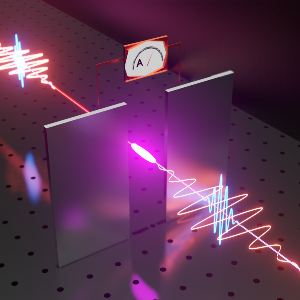Imaging light waveforms in air plasma
12 Oct 2020
An international team that includes physicists at LMU has developed a new method with which to characterize the ultrafast oscillation of the electrical fields associated with light.
12 Oct 2020
An international team that includes physicists at LMU has developed a new method with which to characterize the ultrafast oscillation of the electrical fields associated with light.

© LMU
The electric field associated with visible light oscillates at frequencies on the order of hundreds of billions of times per second. This means a single oscillation of the field lasts for a few femtoseconds (1 fs is equivalent to 10-15 sec). Precise measurements of the extraordinarily rapid rate of change of the electric field during a single oscillation are an essential prerequisite for an understanding of the ultrafast motions of the electrons in atoms, molecules and condensed matter. A collaborative project carried out by groups of physicists based at LMU Munich, the Max Planck Institute for Quantum Optics, and the National Research Council of Canada’s Joint Attosecond Science Laboratory at the University of Ottawa has resulted in the development of a new method, which that enables the evolution of the electric field over the course of single ultrafast oscillations to be displayed on an oscilloscope. While the conventional technique is carried out under high vacuum, the new method works in ambient air. It is based on the use of a two-pulse sequence. – A pump pulse first strips electrons from molecules in the ambient air. This is followed after a variable delay by the pulse to be measured. The shape of its electric-field waveform is revealed by monitoring the currents induced by its interaction with the free electrons in the air plasma. The relative simplicity of this approach should make a valuable tool for the exploration of ultrafast dynamics in the subatomic domain, and the development of ultrafast electronics with switching frequencies in the petahertz range (1015 Hz).Optica, 2020
For further information, see: Attoworld.de